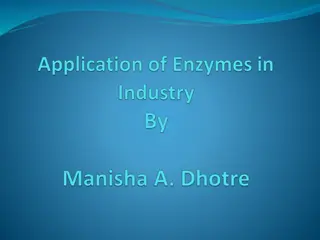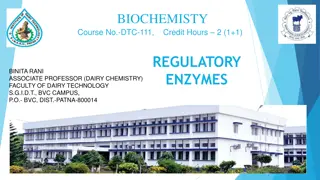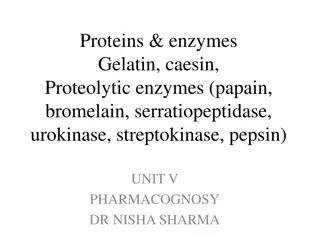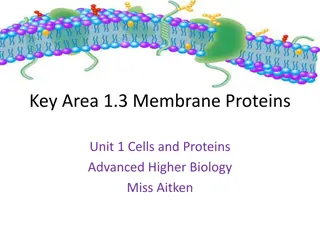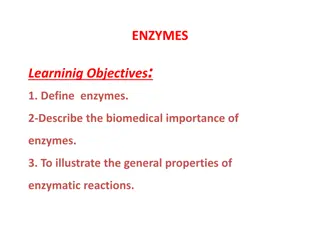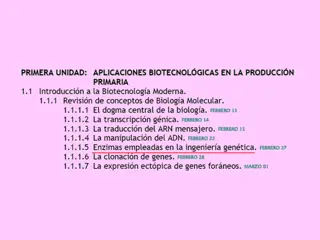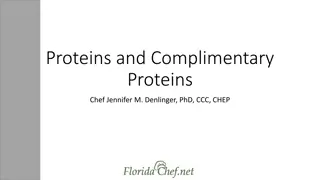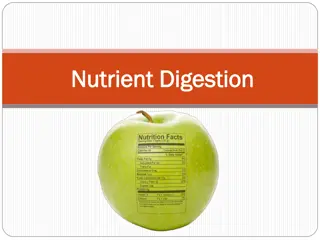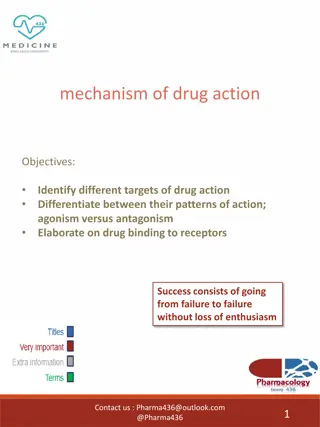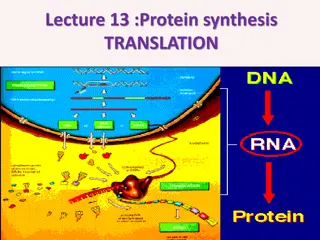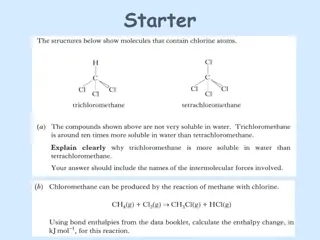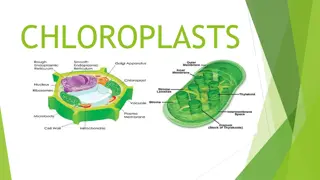Understanding Proteins and Enzymes: Classification, Sources, and Applications
Proteins and enzymes play crucial roles in various biological processes. Enzymes act as catalysts, with different types classified based on their functions. Papain enzyme, derived from Carica papaya, exemplifies proteolytic enzymes used in the food and beverage industry as a meat tenderizer and in cheese manufacturing. Explore the classification, preparation methods, identification tests, and uses of enzymes like papain to appreciate their significance in pharmacognosy and beyond.
Download Presentation

Please find below an Image/Link to download the presentation.
The content on the website is provided AS IS for your information and personal use only. It may not be sold, licensed, or shared on other websites without obtaining consent from the author. Download presentation by click this link. If you encounter any issues during the download, it is possible that the publisher has removed the file from their server.
E N D
Presentation Transcript
Proteins & enzymes Gelatin, caesin, Proteolytic enzymes (papain, bromelain, serratiopeptidase, urokinase, streptokinase, pepsin) UNIT V PHARMACOGNOSY DR NISHA SHARMA
ENZYMES Enzymes are the proteins which act as biological catalysts. Most enzymes act best at temperatures 35-40 C; above 65 C, & presence of moisture, destroy them, activity is negligible at 0 C. Although, they are soluble in water and dilute alcohol, concentrated alcohol precipitates them. pH of medium directly effect their action. Enzymatic activity reduces by HCHO, free iodine, heavy metals and tannins. enzymatic reactions proceed 8 to 10 times more rapidly than the corresponding non-enzymatic reactions. Classification of Enzymes:
ENZYMES Classification of Enzymes: 1. Hydrolases for catalysis of hydrolytic reactions. 2. Transferases for transfer of chemical group from 1 molecule to another. 3. Oxido-reductases catalyse the oxidation-reduction reactions. 4. Lyses catalyse the addition of groups to double bonds vice- versa. 5. Isomerases are responsible for intramolecular rearrangements. 6. Synthetases catalyse the condensation of two molecules coupled with the cleavage of pyrophosphate bond of ATP or similar triphosphate.
ENZYMES On the basis of site of action: Endoenzymes/intracellular: act only inside of cell: ex: synthetases, Isomerases, phosphorylases Exoenzymes: secreted outside cell, ex: proteases, lipases, amylases acting on proteins, lipids or starch Many of the enzymes also possess non-protein chemical groups. An enzyme moiety comprises a protein component 'apoenzyme', and a prosthetic group representing non-protein component. The prosthetic group is also referred as cofactor or coenzyme. Certain metals and vitamins are coenzymes.
PAPAIN ENZYME Biological Source: Mixture of proteolytic enzymes from latex of unripe fruit tree Carica papaya, family Caricaceae Method of Preparation: latex of fruits is collected in aluminium trays + potassium metabisulphite (5 g/kg of latex) is added to latex. Extraneous matter is cleared by passing through sieves. latex is dried in vacuum shelf drier at 55-60 C. By spray- drying method can be done. Dried latex is called papain. Description: light brown or white colored amorphous powder, typical odor & taste. Maximum proteolytic activity between pH 5 - 6. Soluble in water and glycerine. Chemical Nature: Proteolytic enzymes present in papain are mixture of papain and chymopapain, proteolytic enzymes act on polypeptides and amides.
PAPAIN ENZYME Identification Test: 1. It decolorises aqueous potassium permanganate solutions. 2. It causes curdling of milk (Proteolytic activity). It may digest about 35 times its weight of lean meat. Best grades render digestion of 200 300 times their weight of coagulated egg albumin in alkaline media. Uses Used in clarification of beverages & a meat tenderiser. Employed in cheese manufacture as a substitute of rennin. Used for degumming of silk fabrics in textile industry and in leather industry for removing hairs of skins and hides. Medicinally, used as an anti-inflammatory agent. One NF unit of papain represents the activity which releases equivalent of 1 g of tyrosine from a standard casein substrate.
BROMELAIN ENZYME Biological Source: Bromelin is a mixture of proteolytic enzymes isolated from the stem & ripen fruit juice of Ananas comosus (pineapple), family Bromeliaceae. Preparation: fruits are left on plant to ripen to full flavor. Dark green unripe fruits gradually change to yellow and finally to deep orange. The fruits are cut off. The enzyme bromelin does not disappear as the fruit ripens. It is isolated from pineapple juice by precipitation with acetone and also with ammonium sulphide. Characteristics Optimum pH of enzyme 5.0 8.0. pH below 3.0 & above 9.5 inactivates the enzyme. Optimum temperature 50 & 60 C, effective between 20- 65 C too. The moisture content should not exceed 6%. Odorless to slightly putrid , buff colored powder , with irritating taste. Slightly soluble in water. Insoluble in organic solvents : ether, chloroform, alcohol
BROMELAIN ENZYME Chemical Constituents not a single substance, but collection of enzymes & other compounds. It is a mixture of sulphur-containing protein-digesting enzymes, called proteolytic enzymes or proteases. It also contains several other substances in smaller quantities, including peroxidase, acid phosphatase, protease inhibitors, and calcium. Uses Fibrinolytic agent; inhibits platelet aggregation, antiinflammatory effect, Antibiotic potentiation: can modify permeability of organs & tissues to different drugs may be due to enhanced absorption, as well as increased permeability of the diseased tissue which enhances the access of the antibiotic to the site of the infection, digestive enzyme following pancreatectomy, minimizes the severity of angina pectoris and transient ischemic attacks, to treat oedema due to surgery and injury.
SERRATIOPEPTIDASE ENZYME Biological Source: proteolytic enzyme derived from the bacteria belonging to genus Serratia, present in the gut of silk worm. Originally, it was discovered in Serratia E15 species. Now-a-days, it is produced by fermentation bio-technology. Preparation Produced by fermentation technology by using nonpathogenic enterobacteria species such as Serratia E 15. The larvae of silk moth produce this enzyme in their intestine to break down cocoon walls. It can thus be obtained from the silk moth larvae. Characteristics vulnerable to degradation in acidic pH. destroyed by acid in stomach. By Enteric coated tablets absorption through intestine. One unit of the enzyme hydrolyses casein to produce color equivalent to 1.0 mol of tyrosine per minute at pH 7.5 and 35 C.
SERRATIOPEPTIDASE ENZYME Chemical Constituents It is a proteolytic enzyme of protease type XXVI. The preparation contains 7.1 units/mg solid. Uses Widely prescribed antiinflammatory enzyme, Eliminates inflammatory oedema & swelling, accelerate liquefaction of pus and sputum, & enhance the action of antibodies. Used as fast wound healing agent. Proving to be a superior alternative to the nonsteroidal antiinflammatory drugs used to treat rheumatoid arthritis and osteoarthritis. Applications in trauma surgery, plastic surgery, Respiratory medicine, obstetric and gynaecology.
UROKINASE ENZYME Synonym: Uroquinase. Biological Source: It is serine protease enzyme isolated from human urine and from human kidney cells by tissue culture or by recombinant DNA technology. Preparation It is afibrinolytic enzyme produced by recombinant DNA using genetically manipulated E. coli cells. Produced 1stas prourokinase, then converted to active form by plasmin or kallikrein. For medicinal use it is purified directly from human urine. A range of adsorbents like silica gel or kaolin can be used to concentrate and purify the product. Can further be purified by precipitation with NaCl or ethanol or by chromatography. Human urokinase needs sterile filtration, a septic filling and freeze drying.
UROKINASE ENZYME DESCRIPTION It occurs in 2 different forms : single and double polypeptide chain forms. Has a half-life of 10 16 minutes after I.V. administration. It is lyophilised white powder, soluble in water. It is an activator of endogenous fibrinolytic system, which converts plasminogen to plasmin and degrades fibrinogen, fibrin clots and other plasma proteins. Chemical Constituents They are serine proteases occur as a single low molecular weight (33 kDa) and double, high molecular weight (54 kDa) polypeptide chain forms. Uses: used to dissolve (lyse) fibrin or blood clots in anterior chamber of eye and in acute massive pulmonary emboli. administered I.V. dose of 4,400 units/kg body wt./ hr for 12 hrs.
STREPTOKINASE ENZYME Synonym: Estreptokinase, plasminokinase. Biological Source: It is purified bacterial protein produced from the strains of group C -haemolytic S.griseus. Preparation It is a bacteria derived enzyme of serine protease group. It is produced by fermentation using streptococcal culture and isolated from the culture filtrate. It is produced in the form of a lyophilized powder in sterile vials containing 2,50,000 to 7,50,000 IUs. Description: Sterile, friable solid or white powder. Soluble in water with maximum activity at pH 7. Solution at higher conc. is stable for 6 hours at 4 C, otherwise dilute solutions are unstable. USES: Treatment of thromboembolic disorders for the Lysis of pulmonary emboli, arterial thrombus, deep vein thrombus & acute coronary artery thrombosis. Activity is due to activation of plasminogen to a proteolytic enzyme namely plasmin which degrades fibrin clots, fibrinogen and other plasma proteins.
PEPSIN ENZYME Biological Source: animals. It is obtained from the glandular layer (mucous membranes) of fresh stomach of hog, Sus scrofa var domesticus, belonging to family Suidae. Preparation Minced stomach linings are digested with HCl, 37 C, 2hr followed by clarification, controlled evaporation, dialysis and concentration of the digested solution. When processed, solution is subjected carefully to vacuum evaporation, spongy pepsin is obtained. Description: Light buff or white coloured amorphous powder. Also occurs as translucent scales. Has a little acidic or saline taste with slightly meaty odour. Soluble in water, insoluble in alcohol, ether & chloroform. If heated with alkali or pancreatic enzymes, biological activity is lost. Shows maximum activity at pH 1.8. Pepsin has the capacity to digest 2500 times its weight of coagulated egg albumin. It is also available in other forms which may digest even up to 10,000 times their weight of coagulated egg albumin.
PEPSIN ENZYME USES: It is used in the deficiency of gastric secretion. Pepsin is also used in the laboratory analysis of various proteins; in the preparation of cheese, and other protein-containing foods.


